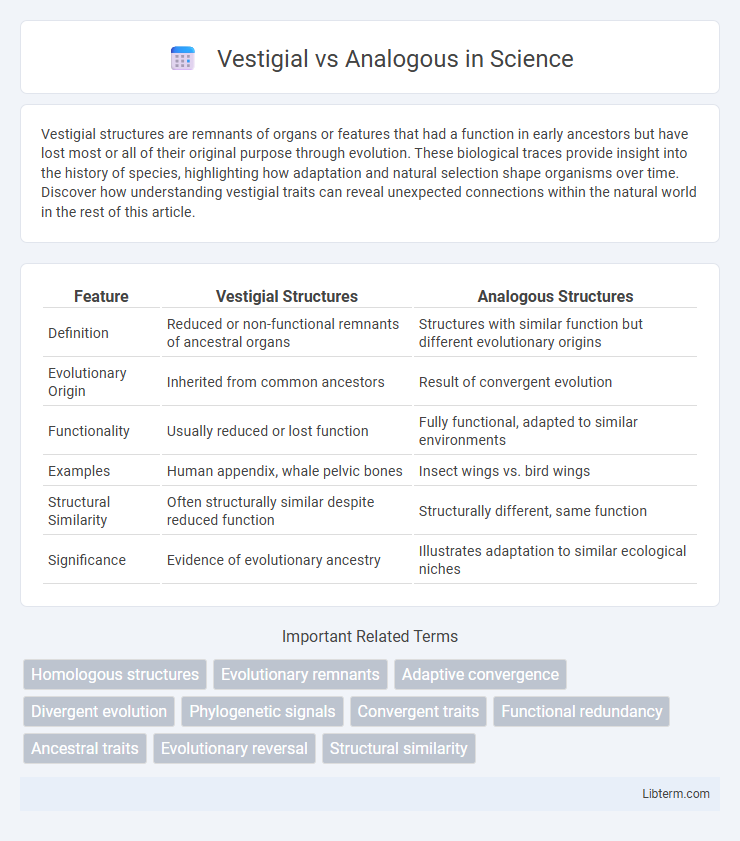Vestigial structures are remnants of organs or features that had a function in early ancestors but have lost most or all of their original purpose through evolution. These biological traces provide insight into the history of species, highlighting how adaptation and natural selection shape organisms over time. Discover how understanding vestigial traits can reveal unexpected connections within the natural world in the rest of this article.
Table of Comparison
| Feature | Vestigial Structures | Analogous Structures |
|---|---|---|
| Definition | Reduced or non-functional remnants of ancestral organs | Structures with similar function but different evolutionary origins |
| Evolutionary Origin | Inherited from common ancestors | Result of convergent evolution |
| Functionality | Usually reduced or lost function | Fully functional, adapted to similar environments |
| Examples | Human appendix, whale pelvic bones | Insect wings vs. bird wings |
| Structural Similarity | Often structurally similar despite reduced function | Structurally different, same function |
| Significance | Evidence of evolutionary ancestry | Illustrates adaptation to similar ecological niches |
Understanding Vestigial Structures
Vestigial structures are anatomical features that have lost most or all of their original function through evolution, such as the human appendix or whale pelvic bones. These remnants provide critical evidence of an organism's evolutionary history and shared ancestry with other species. Understanding vestigial structures helps scientists trace evolutionary pathways and clarify the adaptive changes that have shaped current organisms.
Defining Analogous Structures
Analogous structures are body parts in different species that perform similar functions but do not share a common ancestral origin, reflecting convergent evolution. These structures arise due to similar environmental pressures leading to comparable adaptations, such as the wings of bats and insects used for flight. Unlike vestigial structures, which are remnants of ancestral features, analogous structures highlight functional similarity without genetic homology.
Evolutionary Origins: Vestigial vs Analogous
Vestigial structures originate from ancestral features that have lost their original function through evolution, such as the human appendix derived from a larger cecum in herbivorous ancestors. Analogous structures arise independently in different species due to convergent evolution, fulfilling similar functions despite distinct evolutionary origins, like the wings of bats and insects. Understanding these differences highlights how evolutionary pressures shape anatomy either by modifying existing traits or by evolving new ones with similar purposes.
Key Differences Between Vestigial and Analogous Features
Vestigial features are remnants of organs or structures that had a function in ancestral species but are now reduced or non-functional, such as the human appendix or whale pelvic bones. Analogous features arise independently in unrelated species due to convergent evolution, serving similar functions without a common ancestral origin, like the wings of bats and insects. The key difference lies in their evolutionary origin: vestigial features reflect a shared ancestry with a loss of function, whereas analogous features result from adaptation to similar environments or ecological niches.
Examples of Vestigial Structures in Humans
Vestigial structures in humans include the appendix, which no longer serves its original digestive function but may aid immunity, and the coccyx, or tailbone, a remnant of a tail from ancestral species. Wisdom teeth are another example, once necessary for grinding plant tissue, now often removed due to reduced jaw size. These structures provide evidence of evolutionary history by highlighting traits inherited from distant ancestors that have lost their primary functions.
Notable Analogous Structures Across Species
Notable analogous structures include the wings of bats, birds, and insects, which evolved independently to serve the function of flight despite different anatomical origins. The flippers of dolphins and sharks exhibit analogous features adapted for swimming, arising from distinct evolutionary lineages. These examples illustrate convergent evolution where similar environmental pressures produce comparable adaptations in unrelated species.
Functions and Loss of Function: Vestigial Insights
Vestigial structures, such as the human appendix, represent organs or features that have lost most or all ancestral functions due to evolutionary changes. Analogous structures, like the wings of bats and insects, perform similar functions but evolved independently in different species, lacking common ancestry. Vestigial traits provide key insights into evolutionary history by highlighting how certain functions become obsolete or repurposed over time.
Adaptive Convergence in Analogous Structures
Analogous structures arise from adaptive convergence, where unrelated species develop similar traits to adapt to comparable environmental pressures, such as the wings of bats and insects. These structures serve similar functions but do not share a common evolutionary origin, contrasting with vestigial structures that are remnants of ancestral features with reduced or no function. Adaptive convergence highlights evolutionary processes driving functional similarities despite distinct phylogenetic backgrounds.
Scientific Significance of Vestigial and Analogous Comparisons
Vestigial structures provide crucial evidence for evolutionary history by demonstrating how organisms retain remnants of traits that were functional in ancestors but reduced or lost over time. Analogous structures, arising from convergent evolution, reveal how different species independently adapt similar features to comparable environmental pressures, highlighting functional similarities without common ancestry. Comparing vestigial and analogous traits deepens understanding of evolutionary mechanisms, biological adaptation, and phylogenetic relationships across species.
Vestigial and Analogous Structures in Modern Evolutionary Studies
Vestigial structures, such as the human appendix or whale pelvic bones, provide critical evidence of evolutionary history by highlighting traits that have lost their original function but persist in modern species. Analogous structures, like the wings of insects and birds, demonstrate convergent evolution where unrelated species independently develop similar traits to adapt to comparable environmental challenges. Modern evolutionary studies utilize genetic analysis and comparative anatomy to distinguish between vestigial and analogous structures, deepening our understanding of evolutionary processes and species adaptation.
Vestigial Infographic

 libterm.com
libterm.com